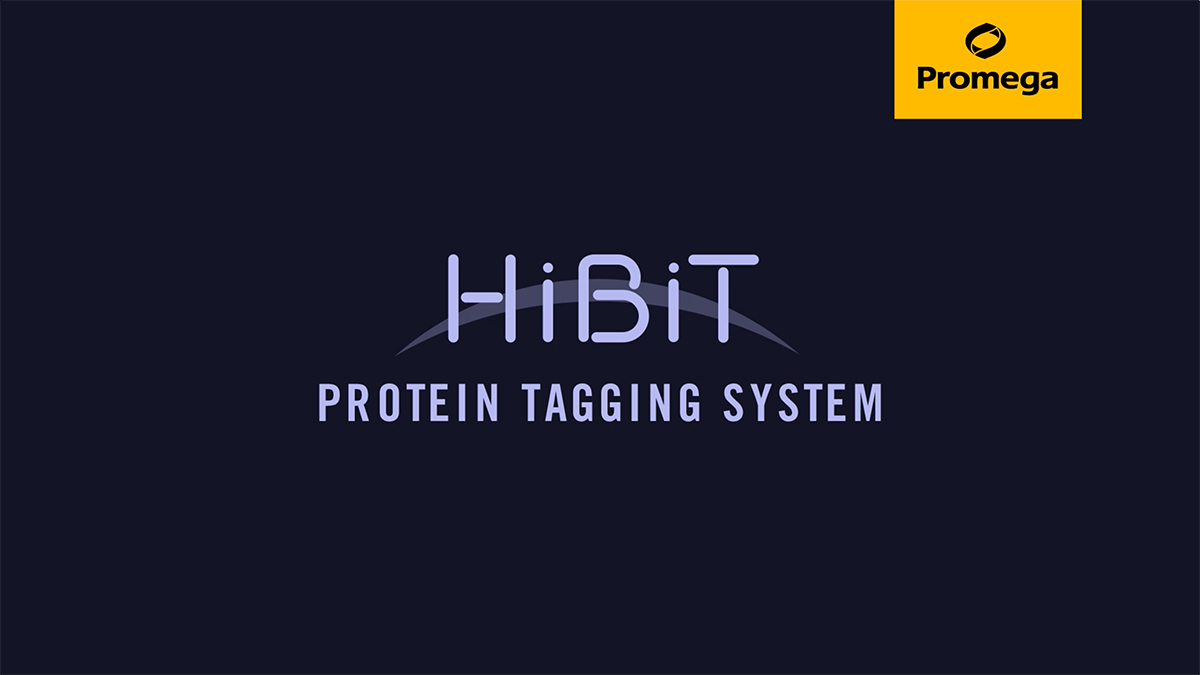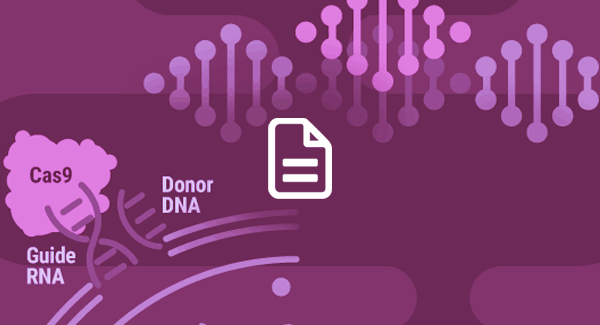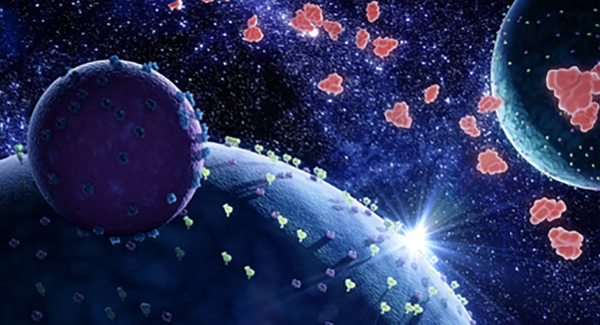CRISPR Cas9 Knock-In Tagging
By using CRISPR/Cas9 gene editing to knock in a bioluminescent tag at endogenous loci of interest, proteins expressed by the native promoter can be studied using simple light output measurements. Compared to overexpression models, endogenously tagged proteins maintain natural epigenetic regulation and stoichiometry with native interacting partners, resulting in improved assay windows, minimized artifacts, and more accurate models of protein biology under physiologically relevant conditions.
HiBiT is a popular tag for studying endogenous proteins. HiBiT is a small, 11 amino acid peptide that binds with high affinity to a larger subunit called LgBiT. The bound complex has high luciferase activity and will generate a bright luminescent signal in the presence of added substrate. The small size of the HiBiT tag allows for higher knock-in efficiency compared to larger tags, without the need for molecular cloning steps, making it well suited to CRISPR/Cas9 editing workflows.
Promega offers a comprehensive selection of CRISPR-edited cell line pools and clones for popular targets and cell backgrounds.

Tagging Endogenous Loci Using CRISPR/Cas9 Knock-ins
Using the combination of CRISPR/Cas9 knock-in and live-cell bioluminescent detection methods, changes in protein abundance can be monitored in real time to better understand cellular protein dynamics.
Why use endogenous tagging?
- Monitor physiological expression levels: no gene dosage effect
- Study genes under control of a native promoter and epigenetic regulation
- Maintain stoichiometry with native interacting partners

Using CRISPR Knock-ins to Monitor Protein Abundance, Internalization and Regulation
Determining Regulated Protein Abundance
Cellular protein levels are naturally modulated by changing cellular conditions, or they can be purposefully manipulated as a therapeutic strategy. Recently, targeting proteins for degradation has emerged as a new small molecule modality, enabling previously undruggable targets to be addressed. Using CRISPR/Cas9 gene editing to endogenously insert bioluminescent tags enables quantitative assays for protein abundance, without the need for target-specific antibodies. These assays are sensitive and easy to read, in end-point or live-cell formats, allowing for detailed analysis of endogenous target protein levels.

Endogenous tagging creates an improved assay window for HIF1A abundance assay. HeLa cells were transiently transfected with different amounts of CMV- or PGK-driven expression constructs for Hif1a-HiBiT; alternatively, HiBiT was tagged to the endogenous locus in HeLa cells using CRISPR/Cas9 gene editing. Cells were treated with a titration of 1,10-phenanthroline as indicated and protein abundance measured using the Nano-Glo® HiBiT Lytic Reagent.

Degradation kinetics of endogenous HiBiT-BRD4 following PROTAC treatment. HiBiT was inserted at the endogenous BRD4 locus in the HEK293 LgBiT Cell Line. Cells were treated with a titration of MZ1 in CO2-independent medium containing Nano-Glo® Endurazine™ Substrate. Luminescence measured in real time on the GloMax® Discover microplate reader.
Internalization of Cell Surface Receptors
Following ligand binding, cell surface receptors often undergo internalization as a mechanism for signal regulation. Using CRISPR/Cas9 gene editing to insert the bioluminescent tag at the extracellular terminus of the receptor, internalization and subsequent trafficking back to the cell surface can be monitored.

Quantification of endogenous membrane receptor internalization following compound treatment. Pools of HeLa cells that were previously CRISPR-edited to insert HiBiT at the endogenous EGFR locus were treated with EGF as indicated. The Nano-Glo® HiBiT Extracellular Detection System was used to specifically detect HiBiT-EGFR expressed at the cell surface.
Downstream Target Gene Regulation
Changes in the abundance or activity of proteins upstream in a signaling pathway often result in modulation of downstream target gene expression. Using CRISPR/Cas9 gene editing, endogenous downstream target genes can be tagged and the expression of their corresponding proteins examined to understand the impacts on target gene regulation. Using live-cell assays, an abundance of downstream targets can be monitored in real time.

Monitoring cMyc levels following degradation of upstream regulatory proteins. MV-4-11 cells, a model of acute myeloid leukemia, were edited using CRISPR/Cas9 to insert HiBiT at the endogenous cMyc loci and co-express LgBiT. Cellular cMyc gene expression levels are positively regulated by BET proteins and should be down-regulated after loss of inhibition or BET family proteins. Following treatment with BET protein degrader compounds dBET1 and MZ1, cMyc levels were monitored in real time. A decrease in BET protein levels resulted in decreased expression of the downstream cMyc target.
How to Perform CRISPR Knock-ins
The CRISPR knock-in process is a simple and efficient method for HiBiT tagging that requires no molecular cloning steps. From gene editing to assaying endogenous biology, the process can be completed in as little as 24 hours.
Getting Started
Choosing a workflow for CRISPR-enabled endogenous biology experiments will depend on the type of experiment, laboratory resources and experience, and the project timeline. You can design your experiment yourself from start to finish, or you can work with Promega to take advantage of our CRISPR-edited cell line pools and clones, available for a variety of target proteins and cell backgrounds. If you need a target or cell line not currently available, our Custom Development team will be happy to assist you.
Option 1: Do It Yourself (DIY)
We can walk you through the process of creating CRISPR knock-ins, step by step.
Option 2: Cell Line Pools and Clones
Our licenses give our clients pass-through rights. Clients need not obtain CRISPR licenses on their own to use our pools and cell lines. Refer to our comprehensive list of cell line pools and clones for popular targets and cell backgrounds.
Option 3: Custom Cell Line Development
Our Assay Development and Services team is ready to discuss your research needs, including your target of interest and preferred cell background.
More Applications of CRISPR Knock-in Gene Editing
The versatility and convenience of the CRISPR knock-in process enable its use in a wide range of applications. Key examples are illustrated here.
Targeted Protein Degradation
Selectively targeting proteins for removal from the cell is a promising new modality for potential therapy.
Target Engagement
Discover sensitive assays to measure compound binding at select target proteins in intact cells.
Protein Internalization and Secretion
Simple, sensitive and scalable bioluminescent assays to quantify receptor internalization and secretion.

GloMax® Discover Microplate Reader
GloMax® Discover is a ready-to-use multimode plate reader developed with Promega reagent chemistries to provide a simple means of detecting luminescence, fluorescence and absorbance. The instrument can be integrated into a high-throughput workflow for all endogenous biology experiments with CRISPR-HiBiT knock-in cell lines.
Do you have questions about using CRISPR knock-ins to study endogenous biology?
CRISPR/Cas9-Enabled Endogenous Biology Resources

Studying Endogenous Protein Dynamics with CRISPR-Mediated Tagging: Understanding Your Options
A comprehensive discussion of methods for knock-in of protein tags, and results of assays to measure endogenous protein function.

CRISPR-Mediated Tagging of Endogenous Proteins with a Luminescent Peptide
This ACS Chem. Biol. publication demonstrates the ability to efficiently tag endogenous proteins with a small luminescent peptide. The method allows sensitive quantitation of protein response dynamics in regulated expression and with covalent modifications.

HiBiT Detection Reagents
A comparison of several methods to detect and quantify any tagged protein with a simple, luminescent signal.